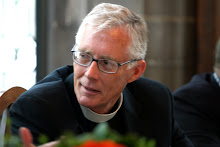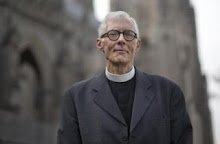Karen Armstrong begins her new book,
Fields of Blood: Religion and the History
of Violence, recalling the way our religious forbears ritualized the
transfer of their sins on to sacrificial animals:
Every
year in ancient Israel the high priest brought two goats into the Jerusalem
temple on the Day of Atonement. He
sacrificed one to expiate the sins of the community and then laid his hands on
the other, transferring all the people’s misdeeds onto its head, and sent the
sin-laden animal out of the city, literally placing the blame elsewhere. In this way, Moses, explained, ‘the goat will
bear all their faults away with it into a desert place.” [Leviticus 16: 21-22]
[Karen Armstrong, Fields of Blood:
Religion and the History of Violence, p. 3]
The first animal was the sacrificial
victim. The second was what we have come
to call the scapegoat. In the Christian history of Good Friday meditations
there is a lot of talk of Jesus as the human symbol of the first but not as
much about how we relate to him as the second.
We seem to be more comfortable thinking of Jesus as the Lamb of God who
takes away, by his death, the sins of the world. We’re a bit more uneasy acknowledging the way
we use him, in Armstrong’s words, to place the blame elsewhere.
Today’s reading from the Book of
Wisdom closely parallels the Suffering Servant Songs of Isaiah, and it rather
uncomfortably reminds us that Jesus is not only the exalted Saving Victim dying
for our sins but also the one on whom we have projected the parts of ourselves
we cannot bear:
Let us lie in wait for the
righteous man, because he is inconvenient to us and opposes our actions; he
reproaches us for sins against the law, and accuses us of sins against our
training. He professes to have knowledge of God, and calls himself a child of
the Lord. He became to us a reproof of our thoughts; the very sight of him is a
burden to us, because his manner of life is unlike that of others, and his ways
are strange. . . . Let us see if his words are true, and let us test what will
happen at the end of his life; for if the righteous man is God’s child, he will
help him, and will deliver him from the hand of his adversaries. Let us test
him with insult and torture, so that we may find out how gentle he is, and make
trial of his forbearance. [Wisdom 2: 1, 12-24]
By his or her very existence, the
righteous person reminds us that we are not righteous. We want him not so much to die for our sins
as just to go away.
Jesus
was not the first scapegoat in human history, and he certainly was not the
last. As T.S. Eliot reminds us,
“Humankind cannot bear very much reality.” We look at Jesus and, though a large
part of us responds to him, another part cannot stand what we see. And so, in what feels from a distance like a
perverse process, we come to hate him for the way he shows, or refuses to show,
ourselves back to us. In many ways Jesus
is a clarifying mirror of human nature.
We see in him what we aspire to.
We see in him what we are and what we are not. It would all be so much easier if he would
just go away.
As
we gather on Good Friday, our experience with Jesus asks us to ponder a couple
of questions about what is going on here.
What are we doing with Jesus?
What is God doing with us?
When
I think about it honestly, the ritual of the scapegoat makes a lot of
sense. It would really be nice if I
could find someone else to take on all the negative stuff about being
human. I love life and I love all the
good things about it. Indeed, the
culture I inhabit tells me I deserve all those good things and that, if I do
things right, I can limit my experience of life only to the enjoyable
part. The image of the good life offered
us by late Capitalist consumer society is a picture of healthy, fulfilled,
happy prosperity. Happiness is presented
as the norm. If you’re not happy, if you’re not healthy, if you’re not
prosperous—well, there’s just something wrong with you. It would be best for all of us if you just
went away.
One
of the things we learn from following Jesus through Holy Week is how deeply false
this consumerist vision of life really is.
The fantasy of a human existence without suffering, loss, and pain is
just that—a fantasy. The hard truth that
some of us never own up to is just how fragile and finite we people really
are. Like it or not, we are all
mortal. Like it or not, we are not in
control of the universe. Like it or not,
we are subject to events and forces beyond our control. If my vision of the good life implies that I
must always be happy, I will leave this world thinking myself a failure and
wanting to project the things I can’t accept about me onto someone else. If my
vision of the good life acknowledges that a full life involves loss and gain,
sickness and health, failure and success then I might just have a chance of
being a real and rounded person. I might
become a bit like Jesus.
So
what, on Good Friday, are we doing with Jesus?
In Karen Armstrong’s words, we’re making him a scapegoat, “transferring all the people’s misdeeds
onto [his] head . . . literally placing the blame elsewhere.” In so doing we’re vainly
trying to forget, deny, and reject our own finitude. By making Jesus the scapegoat, we are
expressing the sad and childish hope that all the pain, suffering, and loss of
life will come to him and not us.
That’s
what we’re doing today with Jesus. What
is God doing with us?
Last
month, the great Swedish poet Tomas
Tranströmer—winner of the 2011 Nobel Prize in Literature—died after years of
incapacitation. In 1990 Tranströmer
suffered a massive stroke which left him partially paralyzed and totally unable
to speak. Yet he continued to write and
publish poems of stark and transcendent beauty. In his poem “Out in the Open”
he says this:
The
sun is scorching. The plane comes in low,
throwing a shadow in the shape of a giant cross, rushing over the ground.
A man crouches over something in the field.
The shadow reaches him.
For a split-second he is in the middle of the cross.
I have seen the cross that hangs from cool church arches.
Sometimes it seems like a snapshot
of frenzy.
throwing a shadow in the shape of a giant cross, rushing over the ground.
A man crouches over something in the field.
The shadow reaches him.
For a split-second he is in the middle of the cross.
I have seen the cross that hangs from cool church arches.
Sometimes it seems like a snapshot
of frenzy.
—Tomas Tranströmer “Out in the Open,”
from The Deleted World
Something—represented
in this poem by an airplane, but standing for what, God? the world?—something
throws the shape and shadow of the cross over the form of a human life. We are in the middle of that cross. It is not only the shape of Jesus’s life. It is also the shape of ours.
“Humankind cannot bear very much
reality.” We would all rather that shadow passed us by. We would all rather send the scapegoat out of
the city. We would all prefer not to be
reminded that a full human life must comprehend both suffering and
abundance. So here’s what God is doing
today with Jesus: God is refusing to let us make him our scapegoat. Because we
cannot stand at the cross very long and deny or forget or reject our own
vulnerability, weakness, and mortality.
In the crucifixion of Jesus we see the fullness of human frailty and the
depth of divine love. You cannot stand
at the cross and come away thinking that life is only what we see in
advertising. You have to come away
having looked into some of that reality that we human beings cannot stand.
It always perplexes that we call
this Friday “Good”. Yet if we let it,
our forced engagement with the reality we cannot stand can be a transforming
experience. We have brought Jesus to the
cross much in the way ancient priests transferred the people’s sins to the
scapegoat. In showing us ourselves to ourselves
in the ugliness and pain of this moment, God has put away forever the wish and
fantasy of the scapegoat. There is no
scapegoat. Each of us must bear our own burdens. Each of us must acknowledge our own
sins. Each of us must accept that as we
crouch over something in the field, the shadow of the cross above us will put
us at some point in its center. God, the
world, and we are cruciform. We are made
in the shape of a cross.
And so this Friday is Good
Friday. God has shown us ourselves in
all our fullness. We can no longer pretend that the hard things in life happen
only to other, less deserving, people.
We now must admit that they happen also to us. And if they happen both to them and to us,
then we have the possibility of a new kind of community. I no longer need to
shun the poor, the sick, the sorrowful, the defeated because I now can see
something of myself in them and something of them in me. Good Friday opens the door not only to the
fullness of being human; Good Friday also opens the door to a new possibility of
community and compassion with each other and the world. That is why we call this Friday “Good”. And
that is why, together, we proceed to give thanks. Amen.


No comments:
Post a Comment